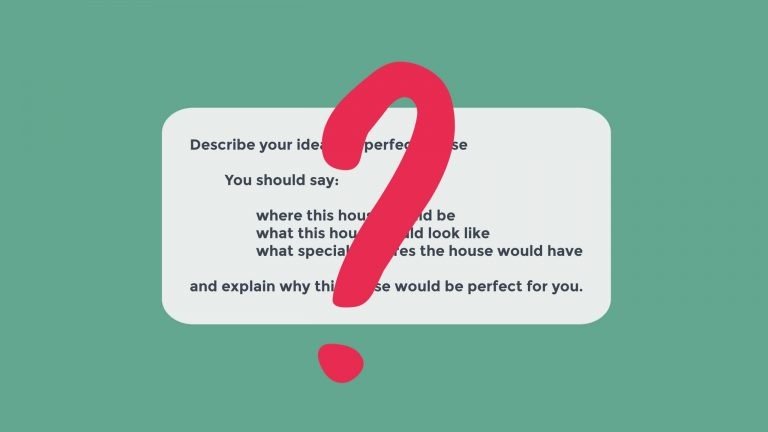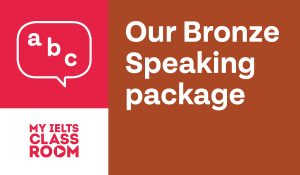
The 9 Types of IELTS Cue Cards
Hey! The IELTS cue cards change every 4 months, with 50% of topics being replaced every April, September, and December. This means that it is almost impossible for students to know and prepare for the 50 possible cards that could appear in their test. Honestly, I think that this is a good thing! Part 2 of the speaking test is supposed to test your ability to speak naturally about a topic, not to test your ability to memorise pre-prepared answer.
So, if you can’t predict what the topic of your cue card will be, does that mean that you can’t prepare for it? Of course not!
You see, even though the particular TOPIC of the cards change, the TYPE of language you need to produce repeats again and again.
And, that’s what I want to look at today – 9 types of cue card that repeat again and again, and what you can do to prepare for them well!
The 9 Types of IELTS Cue Cards
Many students are afraid of Part 2 of the IELTS speaking exam. Honestly, I don’t blame them. Speaking for two minutes without stopping is hard, and it is unnatural to do so without the person you are talking to responding to you in any way (imagine if you were in a coffee shop talking to a friend and they didn’t once nod or say “yes” as you spoke – it would be terrible!). This is why I have already described a lot of techniques on my blog that you can use to keep going, even when you run out of ideas.

However, while most students focus on the TOPIC of the cue cards when they prepare, what many overlook is the importance of the TYPE of language they are being asked to produce. In fact, if we ignore the topic of the card, but focus more on the function of the language, I think that the cards can be broken down into nine broad groups, which each have their own challenges. Let’s look at each in turn so that you can be sure you are able to answer them all.
1. IELTS Cue Cards that ask you to describe an EVENT IN THE PAST
Describe a time when the internet helped you to solve a problem
This is probably the most common type of cue card and one that you definitely have to be prepared for. The main problem for students here is using past tenses throughout the response. Even high-level students can drift from the past to the present if they are not careful (which is why I have never understood why people try to use the PPF method – I would advise any student to avoid talking about the past unless they have to!)

I strongly recommend that when you practice this type of card, you record yourself and check your tenses. Are you always using past tenses to discuss the past, or do you forget and start using present tenses? Take particular care of simple verbs like “have” and “be” – these tend to be the ones that slip back into the present without students realising!
Top Tips for Past Cue Cards:
- Make sure you are always using past tenses to describe the past.
- Remember to give context at the start of your story – remember the examiner does not know you, so you might have to give extra details to make your narrative flow.
- Add details to your story to make it flow naturally and to fill the time – remember, you do not need to cover all of the bullets in your response, so just focus on the story you are telling.
2. IELTS Cue cards that ask you to describe a PERSON
Describe an interesting old person that you have met
Let’s imagine that you are in a cafe and a friend asks you to describe your Mum (or Dad or sister or any close family member). What would you automatically do? Well, I imagine that after you have told them their age and what they do, you might start to list adjectives to describe them: “They are funny / beautiful / kind / friendly / etc.”

Adjectives are pretty much what everybody uses when they are asked to describe a person, and they are a GREAT thing to use in the speaking exam. The only problem is that you would need to list A LOT of adjectives to speak for two minutes! That’s why I recommend that every time you give an adjective to describe a person, you give a real life example to extend your answer.
For example, rather than saying “My grandfather’s friend Kenny is really generous” (which will take you 10 seconds), you can say “My grandfather’s friend Kenny is generous. I remember once we were sitting in his home talking about cooking, and when I mentioned that I really loved making cakes, he gave me a recipe book for fat-free cakes. Another time ….” (which will take at least 20 seconds).
Top Tips for People Cue Cards:
- Don’t rely only on adjectives.
- Give examples / anecdotes that will help you describe the person in detail.
Would you like expert help to improve your IELTS speaking score?
We offer a 5-day intensive course for IELTS test-takers every month that covers all aspects of speaking, from how to approach each section to how to paraphrase well or address the most difficult questions in Part 3. Even better, with every course being run by an ex-examiner, you will be getting feedback is guaranteed to help you to improve your score. You can read more about the course here.

3. IELTS Cue Cards that ask you to describe a HABIT
Describe something that you do that helps you to relax
Habits are things that you usually do and, therefore, cue cards that ask about your habits will require you to answer using mostly the present simple. Although the present simple is often the first tense that we learn, I have noticed that my students in Pakistan / India have problems with this tense as they often use the present continuous instead. For example, rather than saying “I go for walks to relax” they will say “I am going for walks to relax“. If you recognise this problem, be careful!
Try to stick to the present simple when you talk about things that are ALWAY true.
Also, it can be hard to talk about one habit for two minutes. I mean, let’s imagine that what you do to relax is walk. Can you really talk about walking for two minutes? I mean, you can talk about where you walk and why you walk, but this is unlikely to last for more than 60 seconds. So, how can you extend your speech when you talk about habits?

Well, I would encourage you to tell the story of how you STARTED the habit, and also maybe a SPECIFIC EXAMPLE of your doing it (i.e. a time you went on a really memorable walk). Obviously for specific examples, you will switch to the past tenses, so again be careful to make sure that you stay in the past! Finally, don’t be afraid of talking about TWO habits if you run out of things to say about the first!! This is always the best and easiest way to extend. All you have to say is “Another thing I do to relax is …” and then add a totally new habit.
Top Tips for Habit Cue Cards:
- Use the present simple to describe the habit itself.
- Tell the history of your habit or a specific example in the past to extend your speech.
- Describe two habits if you run out of ideas for the first.
Want to listen to two IELTS experts giving feedback and scores for speaking part two? Then listen to this episode of the My IELTS Classroom podcast:
4. IELTS Cue Cards that ask you to describe an OBJECT
Describe a popular product which is made in the region you come from
The main problems that students face when describing an object is lexis – not many students have enough vocabulary to be able to describe their favourite shoes or a laptop for more than 30 seconds.

To resolve this issue, you either have to broaden your vocabulary (which is always a good idea) or learn how to talk about the personal meaning an item has for you, (which can be much easier than giving a physical description). For this example, I would focus on why the product is popular rather than an actual description of the product (which is hard!).
Also, making comparisons can be a great way of making a simple description of a complicated product. For example, it is much easier to say “So, I’m going to describe a balalaika, which is a type of musical instrument a bit like a guitar” than it is to say “So, I’m going to describe a balalaika, which is a three-stringed musical instrument that has a triangular body and a fretted neck”!
Top Tips for Object Cue Cards
- Make sure you have the vocabulary to describe object cue card topics such as (i.e. screen, buttons, apps, crack, etc).
- It is often easier to make a comparison than to describe an unknown object (It is like a/an X).
5. IELTS Cue Cards that ask you to describe a PLACE
Describe a place you remember going to that was full of colour
I think that cue cards that ask you to describe places are similar to those that ask you to describe objects – they are testing your VOCABULARY. You are going to struggle describing a building if you don’t know basic words like ceiling, roof, wall, carpet, etc. In the same way, describing towns without knowing phrases like city centre, in the suburbs, on the coast, or close to the mountains is also going to be difficult.
There are no real shortcuts here. I would recommend that you get hold of a good IELTS vocabulary book and really make sure that you have some good phrases to describe your local area.
Top Tips for Place Cue Cards
I only have one – make sure that you have enough lexis to describe towns / cities / buildings (sorry!).
6. IELTS Cue Cards that ask you to describe a HYPOTHETICAL DESIRE
Describe an outdoor sport you would like to try
These types of cue cards can confuse weaker students. This question is NOT asking what you LIKE doing (i.e. something you already do) but what you WOULD LIKE TO DO (i.e. something you dream about doing in the future). So, if you had the cue card in the example, you would need to describe an outdoor sport that you have NEVER TRIED but would like to one day.

In other words, this type of card is testing to see if you can talk hypothetically, which can be hard. I have found that students often struggle to fill the two minutes when they are given a hypothetical card because they are talking about an experience they have NOT had yet (which is much harder than talking about a true memory). To help you extend your talk, I would roughly follow a plan like this:
React to the question i.e. have you thought about this before? Why not?
Reason – i.e. why have you chosen the thing you will discuss?
Evaluate i.e. how realistic is it that you will actually do this thing one day?
Top Tips for Hypothetical Cue Cards
Recognise that the card is asking you to describe an experience you have never had!
Extend your speech using the three steps above.
Talk about TWO ideas if you need to fill more time (i.e. a second sport that you would like to try).
7. IELTS Cue Cards that ask you to describe a FAVOURITE THING
Describe a book that you enjoyed reading
I have written a whole blog post about the difficulty of describing your favourite things (and what to do to make it easier) so I recommend you go there to read about this in more detail!
However, in short, the main problem is coming up with your favourite book or film on the spot. Also, this is the only card where telling the truth is not always the best idea. The plots of some films are much easier to describe than others! For example, I love the film Fight Club, but I don’t think that I could summarise the plot easily in two minutes. On the other hand, I absolutely hate the film Titanic, but it is pretty easy to summarise (as long as you know the word iceberg!). My point is that you should think not just about the truth, but what you can actually describe!
Top Tips for Favourite Cue Cards
Think about and practice these cards before the exam (read my blog post for more details) to make sure that you are able to describe your “favourites”.
Again, don’t be afraid to describe more than one favourite if you need to speak for longer.
8. IELTS Cue Cards that ask you to describe a CULTURAL EVENT / ITEM
Describe a food that is eaten at a special time in your country
As a examiner, I love these questions as it gives me a chance to sit back and find out something interesting about the culture of the student I am testing. However, I have noticed that students often struggle when describing their own culture because they need to use words that don’t have an English translation (or they do, but the student has no idea what that translation is!).

My advice here would be “Don’t try to translate”! In Russia (where I am currently teaching), many people have a house in the country called a “dacha”. There is literally no translation for this word, so trying to find one is a waste of time. Instead of pausing to search for a translation (which will affect your score for Fluency and Coherence), just tell the examiner the word in your local language.
For example, “Every weekend I go to stay in my friend’s house in the country. I don’t know what the word is in English, but we call it a “dacha“. This is 100% fine and much more natural than trying to give me a translation!
Also, even if the examiner is from your country, it is totally fine to explain the local tradition to them as if they have never heard of it before (even though that might seem strange!).
Top Tips for Favourite Cue Cards
Don’t worry about using words from your native language to describe cultural items if you don’t know the translation – just explain clearly what it is!
Even if your examiner is from your country, pretend that they have never heard of the event / item so that you can describe it fully.
9. IELTS Cue Cards that ask you to describe something CRAZY
Describe something useful you learned in a maths lessons at primary school
In every exam pack, there seem to be one or two questions that I call the “crazy questions”. These are questions that don’t fall into any of the above categories and are totally unpredictable! If you get one of these questions, my advice is to take a deep breath, and answer the question as best you can.

First of all, the examiner will be aware that the topic is strange, so will be impressed with anything you give as an answer! Also, it is totally fine to start your two minutes by explaining why you find this particular topic strange / difficult! For example, here you could definitely start by saying “Well, I am forty-three years old, so it is a bit of a struggle remembering anything that I learned at primary school. I also hate maths, so it is probably the worst subject you could have asked me about. However, what I do remember is …” This would not only sound natural, but it would also take about 20 seconds of the time!!!
Top Tips for Crazy Cue Cards
Stay calm.
Start your two minutes by explaining why you think the topic is difficult.
Do your best to address the card as fully as you can – the examiner knows that it is a hard question, so just do your best!
So, from today, when you are practising your cue cards, try to think of the TYPES of cue card so that you can practice the different TYPES OF LANGUAGE you need to answer them properly. If you need help preparing for IELTS Speaking, then why not join one of our Speaking Packages?
All of our teachers are native speakers who have at least 5 years’ experience, so we can offer you specialised advice and training to ensure you achieve the score you need. We offer a range of options from Mock Speaking Tests (with an accurate score and feedback) to face-to-face lessons that take an in-depth look at every part of the speaking test.

